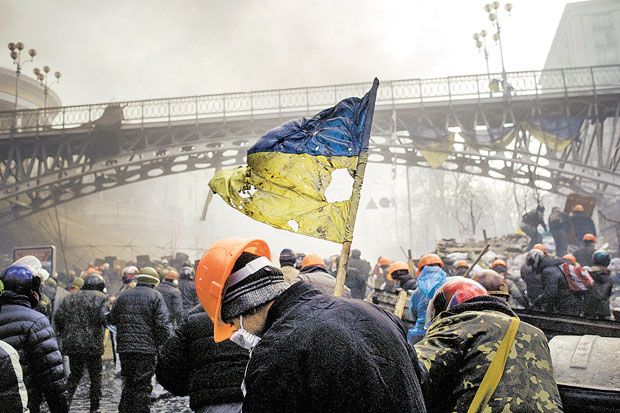Sketch of the Museum of Revolution
Among all the exhibits opened around Maidan’s anniversary, “Maidan. Ukraine. The Path to Freedom” became one of the most important ones
This exhibit is unusual. It was created to show to the Western audience what happened in our country last winter. The project was initiated by Serhii “Foma” Fomenko, an activist, famous rock musician, and Mandry frontman. “The Path to Freedom” has already been to Berlin, London, and New York, and the exhibition term in the US was extended. And now it is Kyiv’s turn.
Foma has been deliberately gathering everything that relates to the revolution, so the exhibit, which occupied the first floor of the Ukrainian House, turned out to be a multi-genre event. “The Path to Freedom” is a combination of fine arts pieces, photographs, posters by the Strike Poster community, books, documentaries, and genuine artifacts from Maidan. Bent, rusty shields, painted helmets, objects melted in endless fires, burnt paving stones, crowbars and spades which were used to pick paving stones from sidewalks, seem to be the most precious items at the display.
These objects rhyme with the visual materials almost perfectly. Remarkably, the vernissage in Kyiv is somewhat expanded. For example, due to complicated logistics, artist Matvey Vaisberg could only send four large canvases abroad, and in Kyiv he managed to fully display his already legendary series “Stina” (The Wall), which consists of 28 paintings dedicated to the revolution’s events. Of course, cinematography was represented by Babylon‘13 group, which documented Maidan ever from its first days. Their winter short movies (and they continue filming, now it is the war in the east) were played non-stop on a large screen, separated with Czech hedgehogs, like the ones that protected the famous first barricade on Instytutska Street. Videos were played on mute; organizers found a better soundtrack for the whole exposition – the sounds of revolution – people’s banging on barrels on Hrushevskoho Street, fired guns, chanting during rallies, etc.
Undoubtedly, documentary photography is the main genre at “Maidan.” Special tribute should be paid to Maksym Dondiuk and Oleksandr Hliadielov. These two are very different, and even contrasting authors. Hliadielov does not present an event, but its specific mood, his rigoristic black-and-white photos concentrate on the emotional atmosphere, the characters’ state. That is how the viewers remember a woman who is rolling a tire to the barricade, or Self-Defense members going to the battle scene armed with sticks. In his colorful works, Dondiuk emphasizes spacious, vivid images of the uprising. For example a photo of a singed flag against the smoke-filled Maidan on February 20, or a Berkut fighter who aims at the crowd standing on a car.
In general, “Maidan. Ukraine. The Path to Freedom” quite fully conveys the beauty, terror, and excitement of the winter events. However, the existence of the exhibition should not end together with the tour, because it is virtually a ready sketch of the much-discussed museum of revolution. And after all, these discussions must yield some result.
COMMENTARIES
Yevhen NYSHCHUK, minister of culture:
“There is no doubt that November 21 was the beginning of very tragic, but at the same time, heroic events, which changed the course of history in Ukraine, and maybe even in Europe and the world. That fight and that Maidan continue. We have a powerful, aggressive imperial enemy which continues infringing upon our dignity, our land. Sometimes people ask me how it all happened. And I start remembering the evenings of November 21 and 24, when 100,000 people came to the European Square for the first time, then November 30, when we said ‘Shame!’ to Yanukovych for humiliating Ukrainians for their desire to be part of the European family; assaults, the New Year, and so on. We remember this, but there are people who captured it.”
Serhii FOMENKO, Mandry frontman:
“Thanks to directors and photographers, we can remember these events again. We want the whole world to know about us, about what happened here, about the deeds of ordinary people. I want to say thanks to all the soldiers who came to the Ukrainian House today, because they defend Ukraine’s independence today. The exhibition will go on a world tour: it is planned to display it at the UN headquarters, Canada, Sweden, Italy, and Poland. However, I think it is not the end. The second part will be dedicated to the war in the east and presented in a form of films and photographs.”
Read an interview with one of the participants of “The Path to Freedom” exhibition, famous Ukrainian documentary photographer Oleksandr Hliadielov in one of the next issues of The Day.






